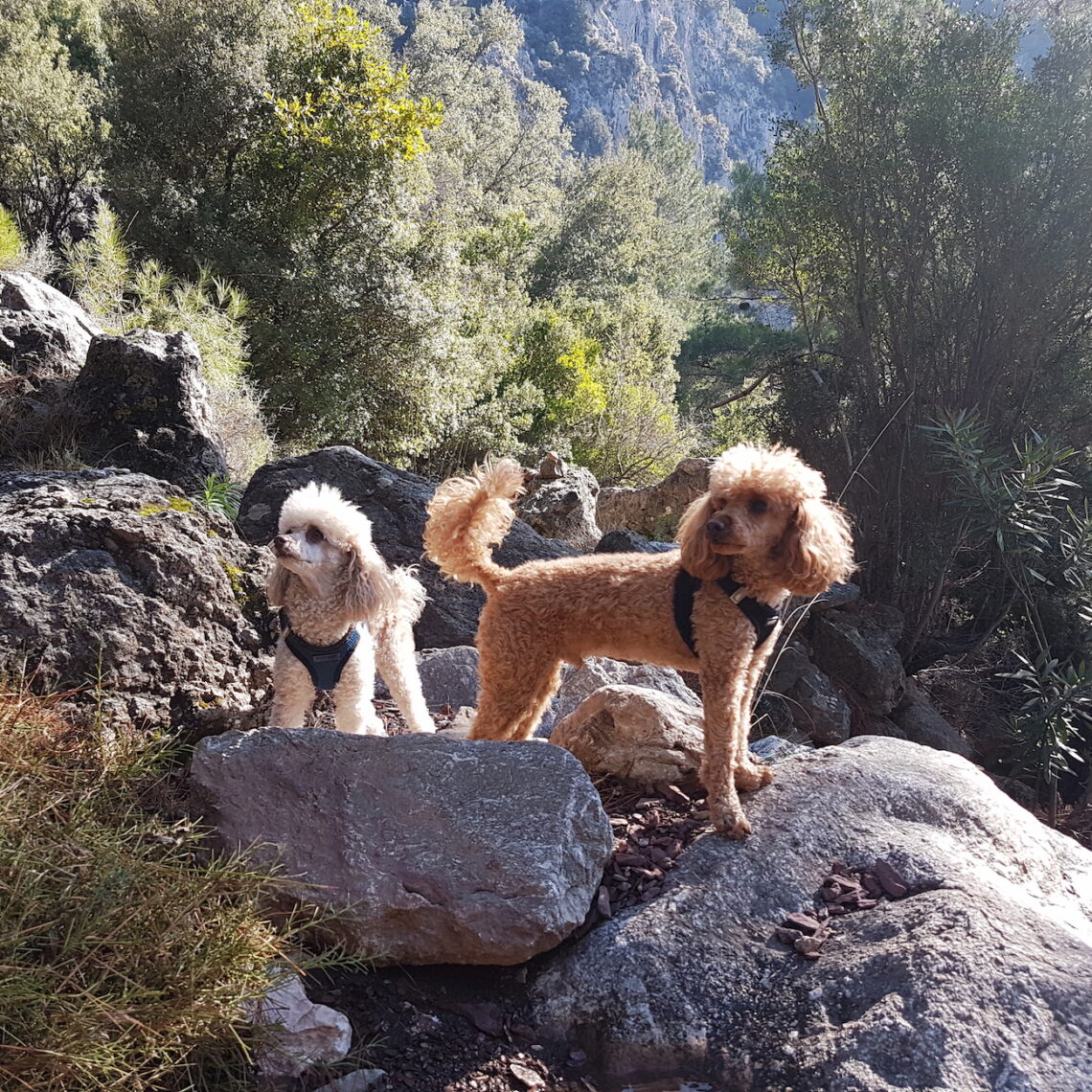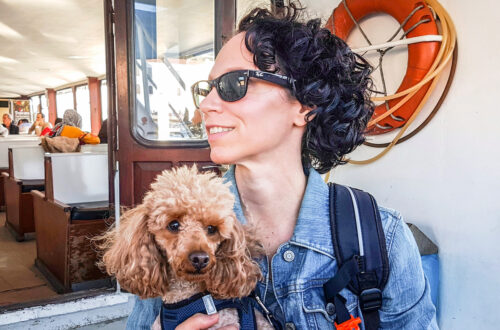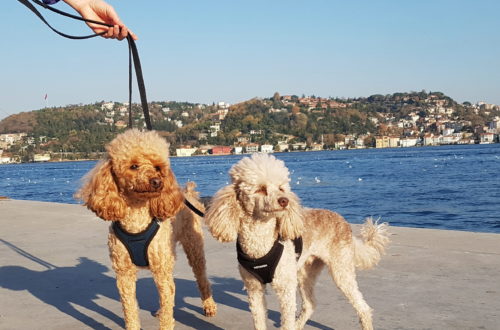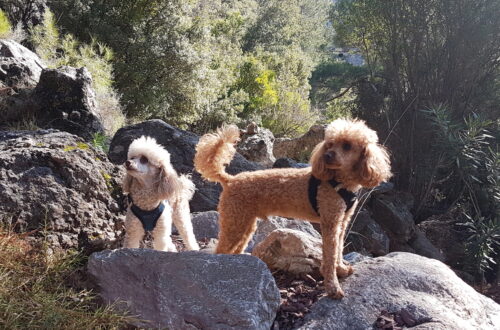
Traveling the World With A Dog
What We’ve Learned About How To Travel With A Dog
It’s been over a year since we first bundled our dogs into their carriers, hopped on a one-way flight from Singapore to Poland and began our life of full-time travel. Although we had enjoyed many vacations around the world in the previous years, this time it was different. Not only was our journey planned to be indefinite, we also had two little furry passengers along for the ride.
In the past year, we’ve discovered that traveling with our dogs is a lot more complicated and usually a bit more expensive. However, once we learned a few basic lessons and established a good travel routine, we found that it’s well worth the extra effort to bring them along.
By way of background, we had been living in Singapore as expats for the past several years when we agreed that we wanted a change of lifestyle. We came up with a vision for our future that would see us step away from our corporate jobs — in other words, retire early — and spend the next few years traveling.
The only real challenge to our plan was that we had two dogs that, of course, we didn’t want to leave behind.
As we researched our options, we discovered other people — bloggers and vloggers — who were traveling long term with their dogs all over the world. This opened our eyes to the possibilities.
We also discovered that our dogs were the right size to come into the plane cabin with us, which made the whole proposition much more feasible. Once we knew the logistics would work, we decided to start our adventure in Europe because it’s such a dog-friendly region.
Again, we wanted to reiterate that traveling with a dog makes everything a little more complicated. But we’ve learned a few things along the way that will hopefully be helpful to you when planning your adventure.
Our Freedom Years is a participant in the Amazon Services LLC Associates Program, an affiliate advertising program designed to provide a means for sites to earn advertising fees by advertising and linking to amazon.com.
Pace of travel
When we were just two humans traveling to new countries, we would try to have as many experiences as possible and get to a new destination every couple of days. However, we’ve found that it’s difficult to travel that quickly with a dog. They are very sensitive to changes in their surroundings and need lots of structure and routine to feel comfortable.
We recommend slow travel where you spend a longer period in a place. Slow travel can be defined as whatever works for you and your dog. It could be a couple weeks or it could be a couple months. Whatever pace you choose, be sure to allow enough time in each place to allow your dog to settle into a new routine and new neighbourhood.
Transportation
Similar to traveling with children, there’s not a lot of room for spontaneity, missed connections or overly long travel days when you’re with a dog. Travel days with a dog are generally more manageable when the entire journey from A to B has been well thought through and you’ve been realistic about how much ground can be covered in a single travel day. If you’ve never flown with your dog before, this video provides a step-by-step through the entire journey.
When it’s just us traveling, it’s not a problem to take a bus, train, plane and car over a 12-hour travel day. With a dog, we’ve found it’s better to break up longer travel days, for example by staying overnight near the airport before a long flight the next day.
When booking your flight, note that dogs carried either in the cabin or cargo will add to the cost of travel. Depending on the airline, it can be an additional $50 to $100 or more per leg of a flight to add an in-cabin pet to your ticket. Bringing a dog along in the cargo hold can be even more. Having a dog can also limit modes of transportation. In Europe, for example, dogs are not allowed on most long distance buses, which makes planes, trains, car rentals or private transfers the other option.
If you’re traveling internationally, we have a video all about the requirements and documents needed to cross borders with your dog.
In terms of gear, here are our essentials for flying with a dog in cabin:
Sturdi Carrier
We put weeks of research into finding the right carrier that could see us through months and hopefully years of travel. In fact, when we finally decided to try the Sturdi for our two little guys, we bought just one at first so that we could test it at home before committing to the second one. Needless to say, the second was purchased almost immediately.
For us, the greatest benefit of the Sturdi is the flexible top. It can squeeze under any airline seat for takeoff. Once we’re in the air, we pull it out so our dogs can enjoy more space with the Sturdi at its full height.
Collapsible Water Bowl
For a short flight – two hours or less — we avoid giving the dogs any water or food as we don’t want to trigger any bathroom needs. On a long flight, we’ll offer a few sips of water using the collapsible bowl but they usually aren’t interested. However, the minute we step off the plane, we pop them out of their carrier for a full rehydration session with this handy bowl. And then quickly scout for the nearest patch of grass.
Accommodations
When searching for a hotel that will take you and your dog, note that a hotel’s pet policy is usually stated quite clearly on their website. If you see online that pets are welcome, we recommend to double check before booking — just to be on the safe side — and also find out if there are extra charges.
For AirBnB rentals, many hosts state in their house rules that they don’t allow pets. However, we find this rule to be very flexible, depending on the size and breed of your dog or whether the host is anxious to fill up empty slots in the booking calendar. When we are shortlisting AirBnBs, we never use the pet friendly filter. Instead we reach out to each AirBnB host and let them know we are traveling with two small dogs and see if they are receptive. Very often they are happy to host us.
Once you’ve arrived at your accommodation, we recommend taking a few steps to dog proof including removing any area rugs as they might get piddled on, even by a well trained dog who is suddenly confused in a new space. If your dog tends to jump onto furniture, consider covering the sofa with a sheet or something you can wash later. Also check for any items within reach that might be a target for play or chewing.
We travel with a few essentials that help our little ones feel at home:
Dog Bed
The moment we pull out these cozy beds in a new Airbnb, our dogs know that they can settle in; this will be home for the next while. The beds may seem bulky for travel but we find they reinforce good habits and routines for two poodles whose environment is otherwise constantly changing.
Toys
Just like for dogs who stay at home, having a few toys on hand is important for dogs who travel. They offer an outlet for play, especially during inclement weather when their daily walks get cut short. They also offer an alternative to playing with (i.e. destroying) other items within an Airbnb. We like a combination of cute animal squeaker toys and rope pull toys — all easy to fit in our luggage.
Dining out
A big part of the travel experience is dining out. Whether or not you can dine out with your pet depends on the local laws and customs. We chose to focus our travel in Europe because it’s so dog friendly. Some countries like Italy allow dogs inside most restaurants and, in almost every country, they can at least join you on an outdoor patio.
It is a good idea to look online for information about this ahead of time so you know what to expect when you arrive. In countries where the customs aren’t so clearcut, there’s no harm in asking if you can bring your dog inside.
Activities
There are lots of travel activities you can do with your dog, like exploring a new city or hiking or taking in the street scene from a cafe patio. We bring our dogs along wherever we go although, if it’s an organized tour, we always ask the operator ahead of time. Typically those are outdoor walking tours but we’ve also brought our dogs along for food tours and even a cave tour. There are, of course, places where we can’t bring dogs such as museums, churches and historic sites so we just plan accordingly.
We have a few accessories to ensure happy excursions with our pups:
Dog Backpack
We love going on long hikes up the nearest mountain and our dogs do too. However, after 8 km or so, our littlest one shows some signs of fatigue. So we pop him into this backpack for a comfortable ride until our next rest stop. What we like about it is that it’s front facing; he can peek over a shoulder to see where we’re heading. We also find it handy for city excursions when we’re walking far distances or need to take transit or are spending in crowded markets; no need to worry about little Huxley being under foot and feeling spooked when he can be safely up and out of the way.
Coat
As full-time travelers, we need to pack for all three seasons. We don’t need quite so many options for our dogs but we do need coats that can stand up to chilly temperatures and a spot of rain or snow. These coats were selected for their warm fleece inners, water resistant outers and reflective tape for greater visibility at night. Plus they look nicely sporty for two dogs on the go.
Seat Belt
We like to rent cars when we travel. Sometimes for just a day, like when we journeyed from Dubrovnik to Split, and sometimes for a full month, like when we toured northern Greece. No matter how long or short the ride, we buckle up our pups with doggie seat belts. As fun as it would be to have a dog on the lap for the drive, it’s not a safe choice, especially on unfamiliar roads. Fortunately these seat belts are easy to have on hand for driving days.
Leash and Harness
Of course, for all excursions outside the home, our dogs are in their leashes and harnesses. While we occasionally enjoy an off-leash romp on a deserted beach, we’ve discovered that it’s necessary to have full control over our pups as we wander historic old town or country lanes. Many countries have large numbers of stray dogs and cats, who can be territorial with newcomers like our little guys. Also, depending on local customs, even dogs that have homes are often wandering the streets freely and without supervision. Ultimately we prefer to play it safe and leash up for every walk.
Separation Anxiety
One of our dogs has separation anxiety, so we have a lot of experience working around with this issue while traveling. If you are traveling solo with a separation anxiety dog, this can be a little limiting in terms of getting time on your own. We recommend organizing a sitter, possibly through your AirBnB host, so you can go off on your own occasionally.
If you’re a couple like we are, then you can take turns for the activities where dogs aren’t allowed, such as going to the museum. However, there are lots of times when we like to leave the dogs at home, in which case we use…
Furbo Dog Camera
When we leave the house together, we use the Furbo to keep an eye on the dogs and manage any anxiety by dispensing treats and soothing words over the microphone. Truthfully, the Furbo takes up quite a bit of space in our luggage but in return we get freedom and peace of mind. We rely on good reviews from our Airbnb hosts in order to secure future dog friendly accommodations — and nothing turns off hosts faster than neighbours complaining about a howling dog who was left behind in an unfamiliar place.
Everyday care
In all the excitement of travel, we can’t forget about our dogs’ ongoing wellness. We carry a few items that help ensure they are healthy and well groomed.
Toothbrush and Toothpaste
Even world-traveling dogs need to be troubled with mundane matters like oral care. We take a few minutes every evening to brush their teeth.They don’t love it but have learned to accept it. Likely it helps that they get a few cuddles along with the brushing.
Grooming
The trouble with poodles and similar breeds is the need to have a haircut every six to eight weeks to manage their ever-growing fur. Instead of trying to find a groomer in every country we visit, we decided to invest in our own dog grooming kit, including clippers and shears. After watching a few YouTube videos on how to groom, the results have been completely serviceable. In fact, we’ve received many compliments from passersby on our dogs’ fine hairdos.
Minerals
We often can’t find high quality dog food in the random cities or towns we visit. Our alternative is to make home cooked meals, combining meat, a starch, some eggs and these minerals. Together with the minerals, we’re able to offer our dogs a nutritionally complete meal no matter where we are in the world. And we’re less dependent on finding a town’s only pet shop and then being disappointed with the selection.
Why travel with a dog?
With all the extra complications, why is it worthwhile to travel with a dog?
For us, having our dog with us makes every place feel like home.
No matter where we are in the world, we have our two little fellows there to fill our lives with the same comfort and happiness that they gave us when we were living in one place.
They also help us keep to a healthy routine, because they still need to be walked a few times a day no matter what city or country we’re in. Finally, dogs are a great way to break the ice with locals. We’ve found that everywhere we go, people want to strike up a conversation with us about our dogs.





4 Comments
Pingback:
Pingback:
Pingback:
Pingback: